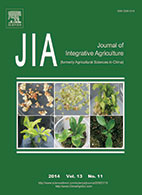|
|
Response of Wheat to Tillage Plus Rice Residue and Nitrogen Management in Rice-Wheat System
Khalid Usman, Ejaz Ahmad Khan, Niamatullah Khan, Abdur Rashid, Fazal Yazdan , Saleem Ud Din
2014, 13(11):
2389-2398.
DOI: 10.1016/S2095-3119(13)60728-5
Zero tillage with residues retention and optimizing nitrogen fertilization are important strategies to improve soil quality and wheat (Triticum aestivum L.) yield in rice (Oryza sativa L.)-wheat system. Field experiments were conducted on silty clay soil (Hyperthermic, and Typic Torrifluvents) in D. I. Khan, Pakistan, to explore the impact of six tillage methods (zero tillage straw retained (ZTsr), ZT straw burnt (ZTsb), reduced tillage straw incorporated (RTsi, including tiller and rotavator), RT straw burnt (RTsb), conventional tillage straw incorporated (CTsi, including disc plow, tiller, rotavator, and leveling operations), CT straw burnt (CTsb)) and five nitrogen rates, i.e., 0, 100, 150, 200, and 250 kg ha-1 on wheat yield. Mean values for N revealed that spikes m-2, grains/spike, 1 000-grain weight (g), and grain yield (kg ha-1) were significantly higher at 200 kg N ha-1 in both the years as well as mean over years than all other treatments. Mean values for tillage revealed that ZTsr produced highest number of spikes m-2 among tillage methods. However, grains/spike, 1 000-grain weight, and grain yield were higher in tillage methods with either straw retained/incorporated than tillage methods with straw burnt. Interaction effects were significant in year 1 and in mean over years regarding spikes m-2, 1 000-grain weight, total soil organic matter (SOM), and total soil N (TSN). ZTsr produced the most spikes m-2 and 1 000-grain weight at 200 kg N ha-1. ZTsr also produced higher SOM and TSN at 200-250 kg N ha-1 at the end of 2 yr cropping. Thus ZTsr with 200 kg N ha-1 may be an optimum and sustainable approach to enhance wheat yield and soil quality in rice-wheat system.
|
